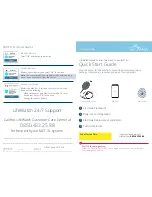
28
NOVO Technical Handbook - NE41 15013-02 v2.0
5.3 Wait between call attempts
When a call attempt fails for some reason NOVO will wait for a configurable amount
of time before making the next call attempt. This state is indicated by blinking of the
Alarm button, see "3.1.2 Alarm button (L4) LED indications".
Alarm types can be configured to allow the user to
cancel an ongoing alarm
during
wait between call attempts. An alarm is cancelled by pressing the
Reset button
(B2)
. If the cancelled alarm type is so configured a
disconnection signal
is played to
indicate this.
If a new alarm with
higher priority
is received during wait between calls the unit
will stop the current call sequence, put the interrupted alarm back in the alarm
queue and handle the new
high priority alarm type
immediately according to its
configuration.
5.4 Roaming
In order to guarantee the best possible reliability over mobile networks, NOVO
employs a roaming mechanism based on end-to-end communication. Even when an
operator is available with good signal strength, there can be problems in the network
backbone. For this reason, NOVO will avoid operators if there is a problem with voice
or data communication to the receiver.
NOVO will roam to a different operator when an alarm sequence cycle has failed or
if the heartbeats to the alarm receiver or Neat Carephone Management Portal do not
work. It will then continue to use the new, working operator for subsequent alarms.
If at some point all operators have been used, an automatic network search is
performed to select the best network as determined by the SIM card.
NOVO must be equipped with a roaming SIM card, preferably a SIM card sold and
verified by NEAT Electronics. The following parameters must be set:
• Number of operators to use in roaming: greater than 1 (one).
• Max heartbeat failures before roaming: greater than 1 (one).
• Cycles of sequence: greater than 1 (one) to ensure that the alarm sequence is
performed again with the new operator.
The roaming mechanism is designed to provide maximum reliability under local
conditions. It will not guarantee connectivity if all base stations within range are
malfunctioning. For this reason, it is recommended to have a secondary carrier as
backup.
Because of the end-to-end communication requirement, the unit will roam if there
is a problem with an alarm receiver (e.g. when heartbeats fail). This can introduce a
delay in the alarm transmission if an alarm is triggered during network registration.
















































